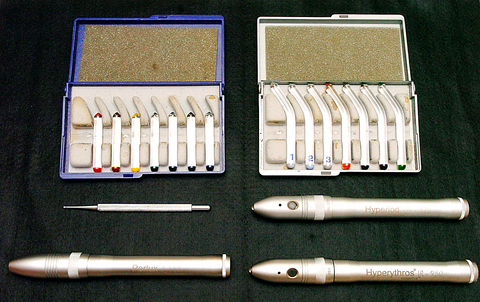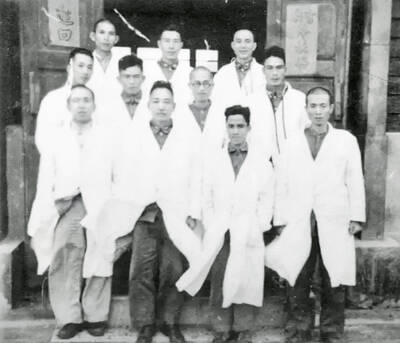While traditional Chinese healing methods will undoubtedly continue to be popular, many in Taiwan are also turning to hybrid holistic treatments such as colorpuncture, which combines the theories of age-old Chinese medicine with modern technology.
Holistic healing is not a new concept, but over the past five years there has been a marked rise in the popularity in Taiwan of such alternative methods of treatment.
Such practices have been ridiculed by the mainstream medical profession. Those who study holistic treatments may be presented with a certificate on completion of their studies but such paperwork is next to worthless in Taiwan.

The government acknowledges practitioners of traditional Chinese medicine even though there is no standardized examination system, but it remains hesitant to recognize the healing abilities of non-medicinal and, dare we say it, new-age treatments. Because of this, practitioners of holistic healing like Ben Chen (
"People are now more open to new types of treatments but there are still some stigmas surrounding what we do," Chen said. "We don't like to advertise because we are not officially recognized. And although large numbers of people are turning to alternative forms of medical treatments, a section of society still treats us like quacks."
To counter these snake oil claims, alternative therapists like Chen argue that conventional medicines do not address the needs of the patient as a whole. Non-medical philosophies are, according to Chen, not only safer, but because they incorporate the physical, mental, and spiritual aspects of the patients' problems, they are also more in tune with the natural balance of the human body.

"Sure, there's nothing wrong with going to the hospital if you have backache, but the medicine that you are prescribed won't deal with the crux of the problem," said Chen. "The pain will be gone, but the underlying cause of the pain will still be there."
For Chen, who is a qualified acupuncturist, holistic healing is both a profession and a form of relaxation. He still practices traditional Chinese medicine, but over the past couple of years he's become immersed in the world of colorpuncture; a form of treatment that is based on acupuncture but was developed by German naturopath Peter Mandel in the late 1970s.
Although many practitioners of colorpuncture in Taiwan have backgrounds in traditional medicine, Chen was initially skeptical of the process when it was introduced to him four years ago. A case of diarrhea and stomach cramps, however, would change his views toward treatment by light.

PHOTOS: WANG MIN-WEI
"I was at work and felt ill. A friend suggested that I try colorpuncture and I thought that's never going to work," he said. "About 30 minutes after I was treated I felt a bit better. The cramps had stopped and I didn't need to go the bathroom. I never believed it would work, let alone work that well."
Like acupuncture, colorpuncture is based on the principle that a balanced flow of chi through the meridian (which resembles an electrical wiring circuit for the body) can ensure good health and general well-being. Unlike needles, however, the lights used in colorpuncture do not penetrate the skin but instead send information into the body's meridian system in the form of light frequencies.
While this is, according to long-term holistic healing devotee Mary Lee (李瑪琍), one of the reasons that colorpuncture has become so popular in recent years, colorpuncture treatment can be a lengthy process. Sessions can range from between 10 to 90 minutes depending on the type of treatment.
"It's non-intrusive in the sense that there are no needles entering the skin, but to be treated properly by
colorpuncture patients must be willing to talk to the practitioners," she said.
"Successful treatment relies on mental and emotional openness. If patients don't feel at ease talking about their emotions, feelings and way of life, then they might as well take pills. Colorpuncture after all is a way to find the cause of the problem and not simply alleviate the immediate pain."
In order to radiate the various frequencies needed to delve into patients' problems, colorpuncturists employ a small handheld torch-like instrument into which a colored glass tip is inserted. The tips are either placed directly onto acupoints or held a short distance above depending on the type of treatment the patient is receiving. Each colored glass tip has its own frequency and the various colors are used to treat different types of ailments.
The basic colors used in colorpuncture are red to physically stimulate, orange for emotional stimulation, yellow for nerve systems, green to ease pain, turquoise to elevate the subconscious, blue to sooth and violet to arouse spiritual emotions.
Along with the basic colors colorpuncturists also employ ultraviolet and infrared lights to stimulate emotional and physical responses.
"I know people are dismissive of all the psycho stuff, but you can feel the energy emitting from the light," said long-term expat and student of colorpuncture, Mana Kalama. "It's based on the relationship between emotions and meridians and as such enables [the patient] to delve into their subconscious. The energy [from the light] has been so strong on occasions that I've had to hold the torch two feet (0.6m) away. It really can be that powerful."
Color therapy has been used as method of healing for thousand of years. Many of the healing systems of ancient cultures were based on the realization that certain colors affect both the human mind and body in certain ways and that light and color can cure both mental and physical problems.
Chen and his fellow colorpuncturists firmly believe, however, that the painless non intrusive form of holistic healing can one day become as widely accepted in Taiwan as the 3,000 year-old art of acupuncture.
"Colorpuncture can be used to both supplement acupuncture treatments and as a standalone treatment," he said. "Like acupuncture [colorpuncture] is based on the reduction or buildup of chi in relation to the meridians. They have so much in common that I can't see why colorpuncture can't one day become as widely popular as acupuncture."
One of the first to realize the possibilities of teaching colorpuncture in Taiwan, holistic healing devotee Mary Lee was introduced to colorpuncture whilst living in India. She has been running Taiwan's sole colorpuncture training center for the past eight years.
In that time hundreds of people have been taught how to heal through colorpuncture. "Initially we introduced colorpuncture as a way to alleviate pain and we had a lot of dentists enrolling in classes," said Lee. "I don't know how many of the students have begun to practice colorpuncture full-time, but I'd say that there must be at least a hundred places in Taiwan where you can receive colorpuncture treatment now."
In the three decades in which colorpuncture has been employed as an alternative form of therapy it has been found to be a safe and effective form of treatment. Individual reactions to light on the body are different, however, and overexposure to bright full-spectrum light can -- if not employed under the supervision of a qualified colorpuncturist -- ?have some adverse side affects. These can include eye irritation, headaches and even insomnia.
"It might appear harmless, but you do have to be careful," said Kalama. "You can't simply go out and purchase the equipment and begin pointing light at people willy-nilly. That could be quite dangerous."

That US assistance was a model for Taiwan’s spectacular development success was early recognized by policymakers and analysts. In a report to the US Congress for the fiscal year 1962, former President John F. Kennedy noted Taiwan’s “rapid economic growth,” was “producing a substantial net gain in living.” Kennedy had a stake in Taiwan’s achievements and the US’ official development assistance (ODA) in general: In September 1961, his entreaty to make the 1960s a “decade of development,” and an accompanying proposal for dedicated legislation to this end, had been formalized by congressional passage of the Foreign Assistance Act. Two

Despite the intense sunshine, we were hardly breaking a sweat as we cruised along the flat, dedicated bike lane, well protected from the heat by a canopy of trees. The electric assist on the bikes likely made a difference, too. Far removed from the bustle and noise of the Taichung traffic, we admired the serene rural scenery, making our way over rivers, alongside rice paddies and through pear orchards. Our route for the day covered two bike paths that connect in Fengyuan District (豐原) and are best done together. The Hou-Feng Bike Path (后豐鐵馬道) runs southward from Houli District (后里) while the

March 31 to April 6 On May 13, 1950, National Taiwan University Hospital otolaryngologist Su You-peng (蘇友鵬) was summoned to the director’s office. He thought someone had complained about him practicing the violin at night, but when he entered the room, he knew something was terribly wrong. He saw several burly men who appeared to be government secret agents, and three other resident doctors: internist Hsu Chiang (許強), dermatologist Hu Pao-chen (胡寶珍) and ophthalmologist Hu Hsin-lin (胡鑫麟). They were handcuffed, herded onto two jeeps and taken to the Secrecy Bureau (保密局) for questioning. Su was still in his doctor’s robes at

Mirror mirror on the wall, what’s the fairest Disney live-action remake of them all? Wait, mirror. Hold on a second. Maybe choosing from the likes of Alice in Wonderland (2010), Mulan (2020) and The Lion King (2019) isn’t such a good idea. Mirror, on second thought, what’s on Netflix? Even the most devoted fans would have to acknowledge that these have not been the most illustrious illustrations of Disney magic. At their best (Pete’s Dragon? Cinderella?) they breathe life into old classics that could use a little updating. At their worst, well, blue Will Smith. Given the rapacious rate of remakes in modern